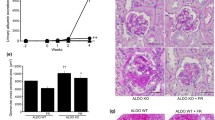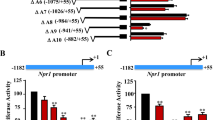Abstract
Along with its natriuretic, diuretic, and vasodilatory properties, atrial natriuretic peptide (ANP), and its guanylyl cyclase/natriuretic peptide receptor-A (GC-A/NPRA) exhibit an inhibitory effect on cell growth and proliferation. However, the signaling pathways mediating this inhibition are not well understood. The objective of this study was to determine the effect of ANP–NPRA system on mitogen-activated protein kinases (MAPKs) and the downstream proliferative transcription factors involving activating protein-1 (AP-1) and cAMP-response element binding protein (CREB) in agonist-stimulated mouse mesangial cells (MMCs). We found that ANP inhibited vascular endothelial growth factor (VEGF)-stimulated phosphorylation of MAPKs (Erk1, Erk2, JNK, and p38), to a greater extent in NPRA-transfected cells (50–60 %) relative to vector-transfected cells (25–30 %). The analyses of the phosphorylated transcription factors revealed that ANP inhibited VEGF-stimulated activation of CREB, and the AP-1 subunits (c-jun and c-fos). Gel shift assays demonstrated that ANP inhibited VEGF-stimulated AP-1 and CREB DNA-binding ability by 67 and 62 %, respectively. The addition of the protein kinase G (PKG) inhibitor, KT-5823, restored the VEGF-stimulated activation of MAPKs, AP-1, and CREB, demonstrating the integral role of cGMP/PKG signaling in NPRA-mediated effects. Our results delineate the underlying mechanisms through which ANP-NPRA system exerts an inhibitory effect on MAPKs and down-stream effector molecules, AP-1, and CREB, critical for cell growth and proliferation.









Similar content being viewed by others
Abbreviations
- ANP:
-
Atrial natriuretic peptide
- GC-A/NPRA:
-
Guanylyl cyclase/natriuretic peptide receptor-A
- VEGF:
-
Vascular endothelial growth factor, AP-1, activating protein-1
- CREB:
-
cAMP response element-binding protein
- MAPKs:
-
Mitogen-activated protein kinase
- MMCs:
-
Mouse mesangial cells
- DMEM:
-
Dulbecco’s modified Eagle’s medium
- PBS:
-
Phosphate-buffered saline
- HEPES:
-
N-(2-Hydroxyethyl) piperazine-N′-(2-ethanesulfonic acid)
- IBMX:
-
3-Isobutyl-1-methyl xanthin
- EMSA:
-
Electrophoretic mobility shift assays
- SDS-PAGE:
-
Sodium dodecyl sulfate-polyacrylamide gel electrophoresis
- PVDF:
-
Polyvinylidene fluoride
- TBST:
-
Tris-buffered saline-tween-20
- DTT:
-
Dithiothreitol
- PMSF:
-
Phenylmethylsulfonyl fluoride
References
de Bold AJ, Borenstein HB, Veress AT, Sonnenberg H (1981) A rapid and potent natriuretic response to intravenous injection of atrial myocardial extract in rats. Life Sci 28:89–94
Brenner BM, Ballermann BJ, Gunning ME, Zeidel ML (1990) Diverse biological actions of atrial natriuretic peptide. Physiol Rev 70:665–699
de Bold AJ (1985) Atrial natriuretic factor: a hormone produced by the heart. Science 230:767–770
Levin ER, Gardner DG, Samson WK (1998) Natriuretic peptides. N Engl J Med 339:321–328
Pandey KN (2005) Biology of natriuretic peptides and their receptors. Peptides 26:901–932. doi:10.1016/j.peptides.2004.09.024
Drewett JG, Garbers DL (1994) The family of guanylyl cyclase receptors and their ligands. Endocr Rev 15:135–162
Mohapatra SS (2007) Role of natriuretic peptide signaling in modulating asthma and inflammation. Can J Physiol Pharmacol 85:754–759
Rosenzweig A, Seidman CE (1991) Atrial natriuretic factor and related peptide hormones. Annu Rev Biochem 60:229–255
Pandey KN (2011) The functional genomics of guanylyl cyclase/natriuretic peptide receptor-A: perspectives and paradigms. FEBS J 278:1792–1807. doi:10.1111/j.1742-4658.2011.08081.x
Anand-Srivastava MB, Trachte GJ (1993) Atrial natriuretic factor receptors and signal transduction mechanisms. Pharmacol Rev 45:455–497
McGrath MF, de Bold ML, de Bold AJ (2005) The endocrine function of the heart. Trends Endocrinol Metab 16:469–477
Koesling D, Schultz G, Bohme E (1991) Sequence homologies between guanylyl cyclases and structural analogies to other signal-transducing proteins. FEBS Lett 280:301–306
Pandey KN, Singh S (1990) Molecular cloning and expression of murine guanylate cyclase/atrial natriuretic factor receptor cDNA. J Biol Chem 265:12342–12348
Lincoln TM, Cornwell TL (1993) Intracellular cyclic GMP receptor proteins. FASEB J 7:328–338
Muslin AJ (2008) MAPK signalling in cardiovascular health and disease: molecular mechanisms and therapeutic targets. Clin Sci 115:203–218
Pimienta G, Pascual J (2007) Canonical and alternative MAPK signaling. Cell Cycle 6:2628–2632
Pandey KN, Nguyen HT, Li M, Boyle JW (2000) Natriuretic peptide receptor-A negatively regulates mitogen-activated protein kinase and proliferation of mesangial cells: role of cGMP-dependent protein kinase. Biochem Biophys Res Commun 271:374–379
Khurana ML, Pandey KN (1995) Catalytic activation of guanylate cyclase/atrial natriuretic factor receptor by combined effects of ANF and GTP gamma S in plasma membranes of Leydig tumor cells: involvement of G-proteins. Arch Biochem Biophys 316:392–398. doi:10.1006/abbi.1995.1052
Sharma GD, Nguyen HT, Antonov AS, Gerrity RG, von Geldern T, Pandey KN (2002) Expression of atrial natriuretic peptide receptor-A antagonizes the mitogen-activated protein kinases (Erk2 and P38MAPK) in cultured human vascular smooth muscle cells. Mol Cell Biochem 233:165–173
Dignam JD (1990) Preparation of extracts from higher eukaryotes. Methods Enzymol 182:194–203
Vellaichamy E, Khurana ML, Fink J, Pandey KN (2005) Involvement of the NF-kappa B/matrix metalloproteinase pathway in cardiac fibrosis of mice lacking guanylyl cyclase/natriuretic peptide receptor A. J Biol Chem 280:19230–19242. doi:10.1074/jbc.M411373200
Ferrara N, Gerber HP (2001) The role of vascular endothelial growth factor in angiogenesis. Acta Haematol 106:148–156
Patan S (2004) Vasculogenesis and angiogenesis. Cancer Treat Res 117:3–32
Kerbel R, Folkman J (2002) Clinical translation of angiogenesis inhibitors. Nat Rev Cancer 2:727–739. doi:10.1038/nrc905
Ruderman JV (1993) MAP kinase and the activation of quiescent cells. Curr Opin Cell Biol 5:207–213
Nelson PR, Yamamura S, Mureebe L, Itoh H, Kent KC (1998) Smooth muscle cell migration and proliferation are mediated by distinct phases of activation of the intracellular messenger mitogen-activated protein kinase. J Vasc Surg 27:117–125
Bornfeldt KE, Krebs EG (1999) Crosstalk between protein kinase A and growth factor receptor signaling pathways in arterial smooth muscle. Cell Signal 11:465–477
Cardoso LE, Little PJ, Ballinger ML, Chan CK, Braun KR, Potter-Perigo S, Bornfeldt KE, Kinsella MG, Wight TN (2010) Platelet-derived growth factor differentially regulates the expression and post-translational modification of versican by arterial smooth muscle cells through distinct protein kinase C and extracellular signal-regulated kinase pathways. J Biol Chem 285:6987–6995. doi:10.1074/jbc.M109.088674
Ladetzki-Baehs K, Keller M, Kiemer AK, Koch E, Zahler S, Wendel A, Vollmar AM (2007) Atrial natriuretic peptide, a regulator of nuclear factor-kappaB activation in vivo. Endocrinology 148:332–336
Pandey KN (2008) Emerging roles of natriuretic peptides and their receptors in pathophysiology of hypertension and cardiovascular regulation. J Am Soc Hypertens 2:210–226. doi:10.1016/j.jash.2008.02.001
Oliver PM, John SW, Purdy KE, Kim R, Maeda N, Goy MF, Smithies O (1998) Natriuretic peptide receptor 1 expression influences blood pressures of mice in a dose-dependent manner. Proc Natl Acad Sci USA 95:2547–2551
Pedram A, Razandi M, Levin ER (2001) Natriuretic peptides suppress vascular endothelial cell growth factor signaling to angiogenesis. Endocrinology 142:1578–1586
Pandey KN, Pavlou SN, Inagami T (1988) Identification and characterization of three distinct atrial natriuretic factor receptors. Evidence for tissue-specific heterogeneity of receptor subtypes in vascular smooth muscle, kidney tubular epithelium, and Leydig tumor cells by ligand binding, photoaffinity labeling, and tryptic proteolysis. J Biol Chem 263:13406–13413
Sugimoto T, Haneda M, Togawa M, Isono M, Shikano T, Araki S, Nakagawa T, Kashiwagi A, Guan KL, Kikkawa R (1996) Atrial natriuretic peptide induces the expression of MKP-1, a mitogen-activated protein kinase phosphatase, in glomerular mesangial cells. J Biol Chem 271:544–547
Prins BA, Weber MJ, Hu RM, Pedram A, Daniels M, Levin ER (1996) Atrial natriuretic peptide inhibits mitogen-activated protein kinase through the clearance receptor. Potential role in the inhibition of astrocyte proliferation. J Biol Chem 271:14156–14162
Hutchinson HG, Trindade PT, Cunanan DB, Wu CF, Pratt RE (1997) Mechanisms of natriuretic-peptide-induced growth inhibition of vascular smooth muscle cells. Cardiovasc Res 35:158–167
Chrisman TD, Garbers DL (1999) Reciprocal antagonism coordinates C-type natriuretic peptide and mitogen-signaling pathways in fibroblasts. J Biol Chem 274:4293–4299
Leitman DC, Andresen JW, Catalano RM, Waldman SA, Tuan JJ, Murad F (1988) Atrial natriuretic peptide binding, cross-linking, and stimulation of cyclic GMP accumulation and particulate guanylate cyclase activity in cultured cells. J Biol Chem 263:3720–3728
Hamad AM, Johnson SR, Knox AJ (1999) Antiproliferative effects of NO and ANP in cultured human airway smooth muscle. Am J Physiol 277:L910–L918
Klaiber M, Dankworth B, Kruse M, Hartmann M, Nikolaev VO, Yang RB, Volker K, Gassner B, Oberwinkler H, Feil R, Freichel M, Groschner K, Skryabin BV, Frantz S, Birnbaumer L, Pongs O, Kuhn M (2011) A cardiac pathway of cyclic GMP-independent signaling of guanylyl cyclase A, the receptor for atrial natriuretic peptide. Proc Natl Acad Sci USA 108:18500–18505. doi:10.1073/pnas.1103300108
Haneda M, Araki S, Sugimoto T, Togawa M, Koya D, Kikkawa R (1996) Differential inhibition of mesangial MAP kinase cascade by cyclic nucleotides. Kidney Int 50:384–391
Hayashi D, Kudoh S, Shiojima I, Zou Y, Harada K, Shimoyama M, Imai Y, Monzen K, Yamazaki T, Yazaki Y, Nagai R, Komuro I (2004) Atrial natriuretic peptide inhibits cardiomyocyte hypertrophy through mitogen-activated protein kinase phosphatase-1. Biochem Biophys Res Commun 322:310–319
Armesilla AL, Lorenzo E, Gomez del Arco P, Martinez-Martinez S, Alfranca A, Redondo JM (1999) Vascular endothelial growth factor activates nuclear factor of activated T cells in human endothelial cells: a role for tissue factor gene expression. Mol Cell Biol 19:2032–2043
Schinelli S, Zanassi P, Paolillo M, Wang H, Feliciello A, Gallo V (2001) Stimulation of endothelin B receptors in astrocytes induces cAMP response element-binding protein phosphorylation and c-fos expression via multiple mitogen-activated protein kinase signaling pathways. J Neurosci 21:8842–8853
Mayo LD, Kessler KM, Pincheira R, Warren RS, Donner DB (2001) Vascular endothelial cell growth factor activates CRE-binding protein by signaling through the KDR receptor tyrosine kinase. J Biol Chem 276:25184–25189. doi:10.1074/jbc.M102932200
Isono M, Haneda M, Maeda S, Omatsu-Kanbe M, Kikkawa R (1998) Atrial natriuretic peptide inhibits endothelin-1-induced activation of JNK in glomerular mesangial cells. Kidney Int 53:1133–1142. doi:10.1046/j.1523-1755.1998.00869.x
Swart JM, Chiles TC (2000) Rescue of CH31 B cells from antigen receptor-induced apoptosis by inhibition of p38 MAPK. Biochem Biophys Res Commun 276:417–421
Rius J, Martinez-Gonzalez J, Crespo J, Badimon L (2004) Involvement of neuron-derived orphan receptor-1 (NOR-1) in LDL-induced mitogenic stimulus in vascular smooth muscle cells: role of CREB. Arterioscler Thromb Vasc Biol 24:697–702. doi:10.1161/01.ATV.0000121570.00515.dc
Cuenda A, Rousseau S (2007) p38 MAP-kinases pathway regulation, function and role in human diseases. Biochim Biophys Acta 1773:1358–1375
Acknowledgments
Authors wish to thank Huong Nguyen and Gevoni Bolden for technical assistance and Mrs. Kamala Pandey for assistance in typing of this manuscript. Our special thanks are due to Dr. Bharat B. Aggarwal, Department of Experimental Therapeutics and Cytokine Research Laboratory at MD Anderson Cancer Center and Dr. Susan L. Hamilton, Department of Molecular Physiology and Biophysics at Baylor College of Medicine for providing their facilities during our displacement period due to Hurricane Katrina. This work was supported from the National Institutes of Health grant (HL57531).
Author information
Authors and Affiliations
Corresponding author
Rights and permissions
About this article
Cite this article
Tripathi, S., Pandey, K.N. Guanylyl cyclase/natriuretic peptide receptor-A signaling antagonizes the vascular endothelial growth factor-stimulated MAPKs and downstream effectors AP-1 and CREB in mouse mesangial cells. Mol Cell Biochem 368, 47–59 (2012). https://doi.org/10.1007/s11010-012-1341-8
Received:
Accepted:
Published:
Issue Date:
DOI: https://doi.org/10.1007/s11010-012-1341-8




